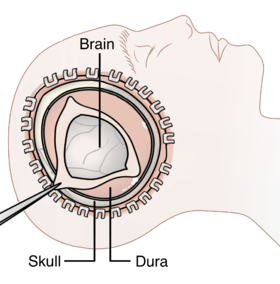| Decompressive craniectomy | |
|---|---|
 Diagram showing the elements of a decompressive craniectomy | |
| ICD-9-CM | 01.2, 02.02 |
| MeSH | D056424 |
Decompressive craniectomy (crani- + -ectomy) is a neurosurgical procedure in which part of the skull is removed to allow a swelling or herniating brain room to expand without being squeezed. It is performed on victims of traumatic brain injury, stroke, Chiari malformation, and other conditions associated with raised intracranial pressure. Use of this surgery is controversial.[1]
The procedure evolved from a primitive form of surgery known as trepanning. The older procedure, while common in prehistoric times, was deprecated in favor of other, less invasive treatments as they were developed; although it was still performed with some frequency prior to the twentieth century, its resurgence in modern form became possible only upon the development of precision cutting tools, cranial drills, and sophisticated post-operative care such as antibiotics.
- ^ Kunze, E; Meixensberger J; Janka M; Sorensen N; Roosen K (1998). "Decompressive Craniectomy in Patients with Uncontrollable Intracranial Hypertension". Intracranial Pressure and Neuromonitoring in Brain Injury. Acta Neurochirurgica. Supplement. Vol. 71. pp. 16–18. doi:10.1007/978-3-7091-6475-4_5. ISBN 978-3-7091-7331-2. PMID 9779131.